Gauge charts, often referred to as dial or speedometer charts, are effective tools for visualizing progress toward a goal. They mimic the appearance of a vehicle's speedometer by using a pointer to indicate data values on a gauge.
Although Excel doesn't have a built-in gauge chart type, it's possible to create one by combining a doughnut chart and a pie chart. This method allows you to represent one data field's performance on a scale from minimum to maximum.
Set Up the Data for the Gauge Chart
Preparing the data is the first step in creating a gauge chart. You'll need to organize three separate data tables: one for the dial, one for the pointer, and an optional one for chart data.
Arrange your data as follows:
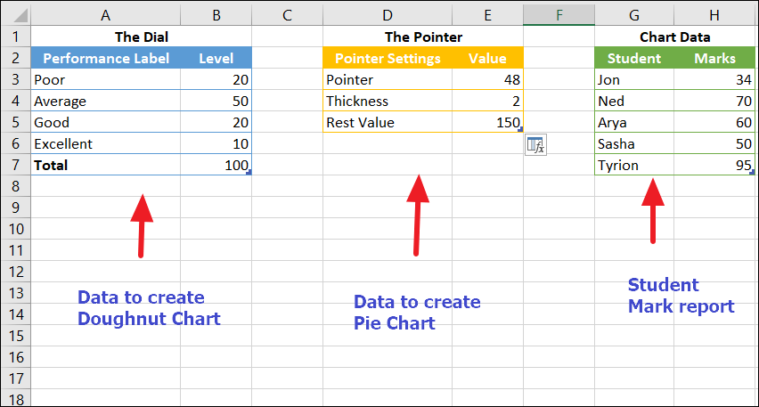
The Dial
- Performance Labels: These are the labels you want displayed on the dial, such as Poor, Average, Good, and Excellent.
- Levels: These values divide the speedometer into different sections.
The Pointer
The pointer data determines the position and appearance of the needle on the gauge chart.
- Pointer: This value specifies where the needle should point on the gauge chart.
- Thickness: This sets the width of the needle. It's advisable to keep this value under five for optimal appearance.
- Rest Value: This value represents the remaining portion of the pie chart. It can be calculated using the formula
=200-(E3+E4), which should be entered in cell E5.
Create a Doughnut Chart
Step 1: With your data prepared, select the values under the 'Levels' column in the first table (the Dial data). Navigate to the Insert tab, click on the Insert Pie or Doughnut Chart icon in the Charts group, and choose the Doughnut chart type from the dropdown menu.
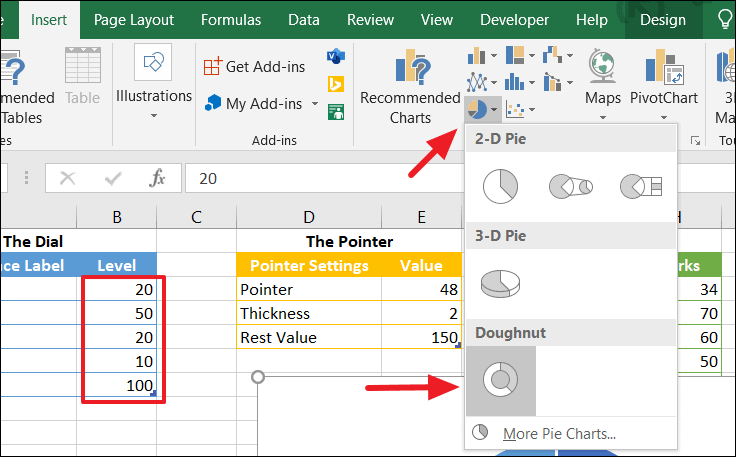
After inserting the chart, remove the default chart title and legend to simplify the visualization. The resulting doughnut chart will display a semi-circle representing the 'Level: 100' on one side and the other levels on the opposite side.

Rotate the Doughnut Chart and Remove the Chart Border
Step 2: To adjust the chart's orientation, right-click on any colored segment of the chart and select Format Data Series from the context menu.
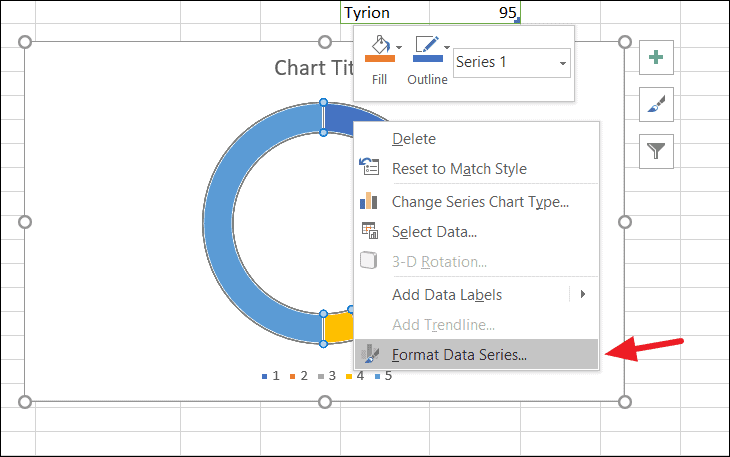
In the Format Data Series pane that appears on the right, set the Angle of first slice to 270° using the slider or by typing directly into the box. You can also adjust the Doughnut Hole Size if desired.

Step 3: To remove the chart borders for a cleaner look, stay in the Format Data Series pane, click on the Fill & Line icon, expand the Border section, and select No line.
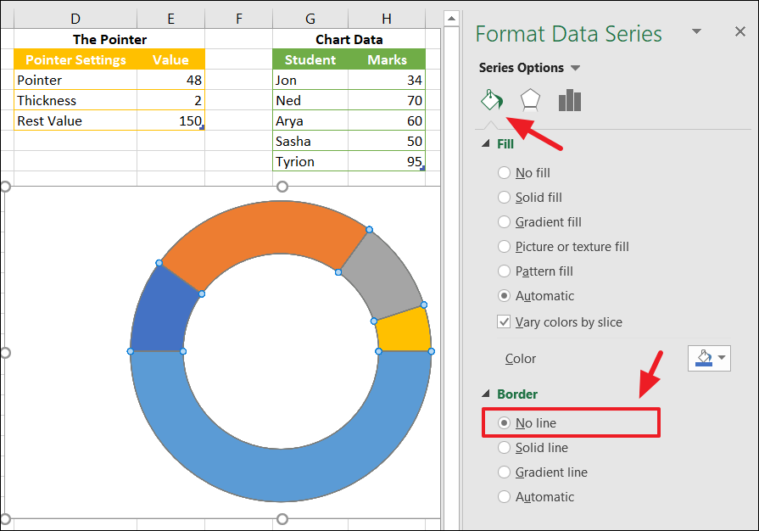
Transform the Doughnut Chart into a Semi-Circle
Step 4: Since gauge charts are typically not full circles, you'll need to hide the bottom portion of the doughnut chart to create a semi-circle. Double-click on the bottom slice of the chart to select it, opening the Format Data Point pane. In the Fill & Line tab, select No fill under the Fill section to make this slice transparent.

Customize the Slice Colors
Step 5: To enhance the visual appeal of your chart, change the colors of the remaining slices. Double-click on a slice to select it, and in the Format Data Point pane, go to the Fill & Line tab. Click on the Fill Color icon and choose a color from the palette for that slice.
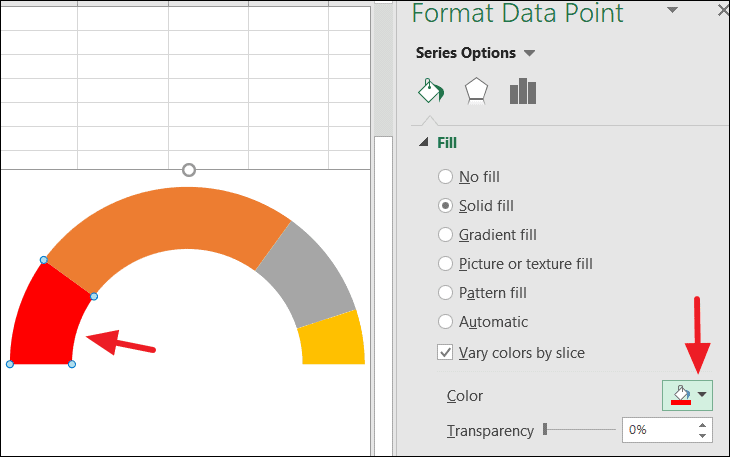
Repeat this process for each slice until all sections of the chart have your desired colors. Your chart should now look similar to this:
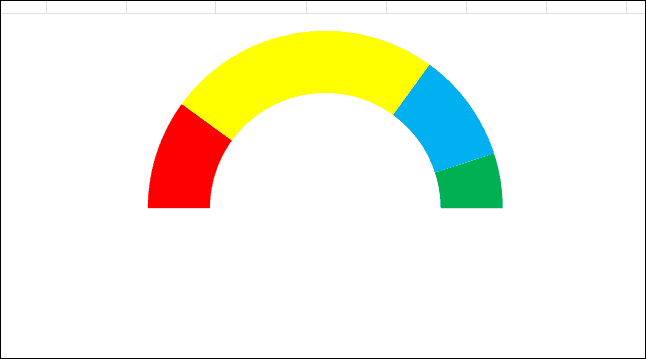
Add Data Labels to the Chart
Step 6: To make the gauge chart informative, add data labels. Right-click on any slice, select Add Data Labels, and then choose Add Data Labels again from the submenu.
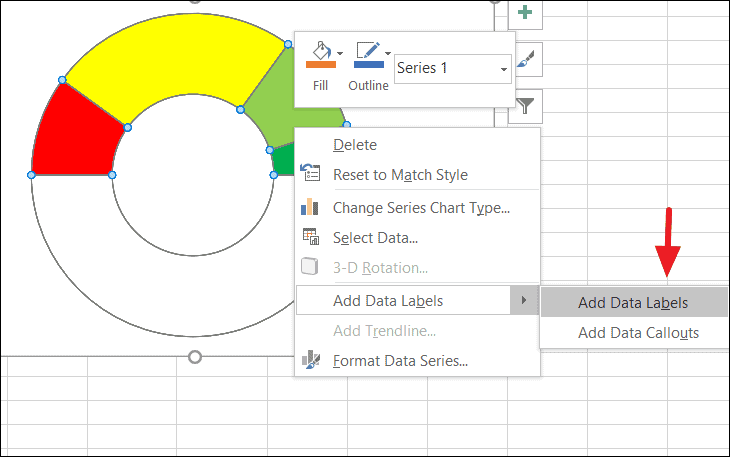
This action will display the level values from the 'Levels' column of your data table on the chart. Double-click on the data label for the bottom (now hidden) slice and delete it to remove unnecessary clutter.
Step 7: To customize the labels, right-click on any data label and select Format Data Labels. In the pane, click on Value From Cells. When the Data Label Range dialog box appears, select the cells under 'Performance Labels' in your data table (excluding the 'Total' label), and click OK.

Uncheck the Values option in the Format Data Labels pane to display only the labels you selected.

Create the Pointer Using a Pie Chart
Step 8: To add a pointer to your gauge chart, you'll need to combine it with a pie chart. Right-click on the existing chart and select Select Data from the context menu.

In the Select Data Source dialog, click the Add button to open the Edit Series dialog box. Enter Pointer in the Series Name field. For the Series Values, delete the default value and select the range containing the 'Pointer', 'Thickness', and 'Rest Value' data from your pointer table (e.g., E3:E5). Click OK to confirm.

Click OK again to close the Select Data Source dialog box.
Convert the Pointer Doughnut Chart to a Pie Chart
Step 9: Next, you'll change the newly added doughnut chart (representing the pointer) into a pie chart. Right-click on the chart and select Change Series Chart Type.
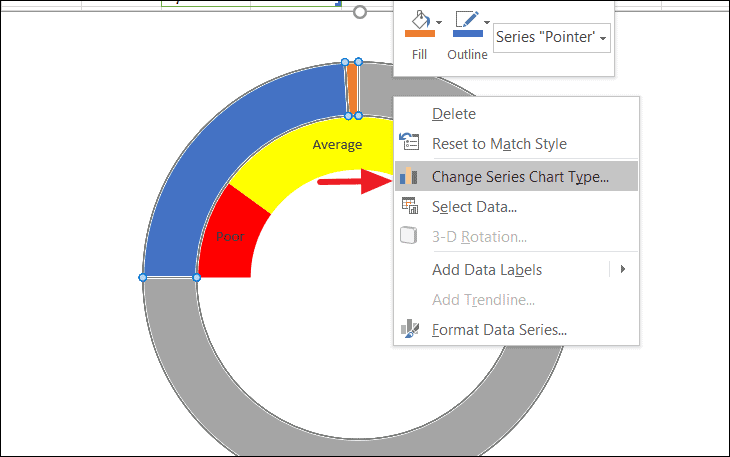
In the Change Chart Type dialog, go to the Combo category. For the series named 'Pointer', change the Chart Type to Pie from the dropdown menu. Check the Secondary Axis box next to the 'Pointer' series, then click OK.
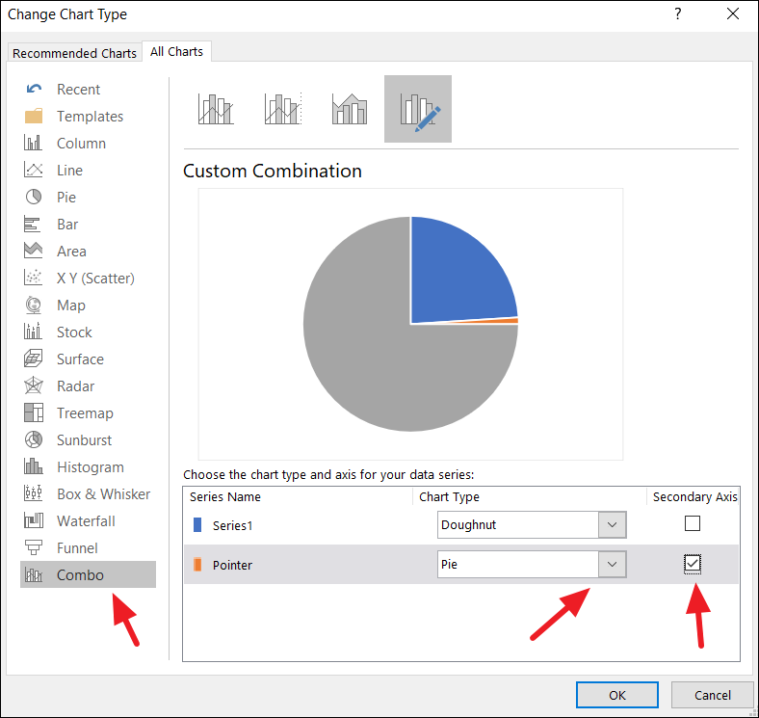
Your chart will now include a pie chart overlaying the doughnut chart, which will serve as the pointer.

Transform the Pie Chart into a Pointer (Needle)
Align the Pie Chart with the Doughnut Chart
Step 10: To ensure the pie chart aligns correctly with the doughnut chart, right-click on the pie chart portion and select Format Data Series. In the Format Data Series pane, set the Angle of first slice to 270°, just as you did with the doughnut chart.
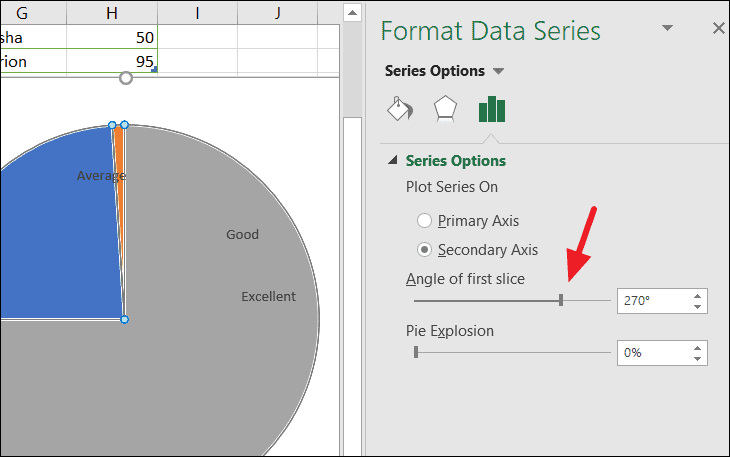
Remove Pie Chart Borders
Step 11: Remove the borders of the pie chart for a seamless appearance. In the Format Data Series pane, go to the Fill & Line tab, expand the Border section, and select No line.
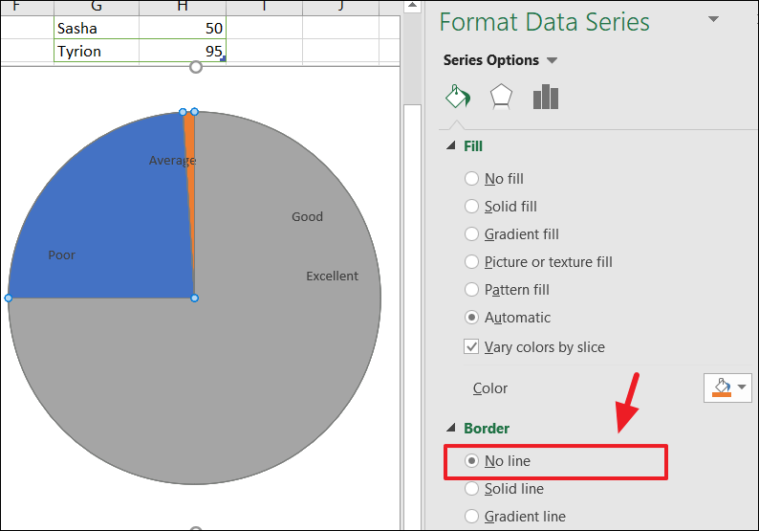
At this point, your chart will display three slices in the pie chart: two large ones and a thin slice at the top.
Configure the Pointer Appearance
Step 12: To create the pointer, you'll need to hide the two large slices of the pie chart, leaving only the thin slice (the needle). Double-click on one of the large slices to select it, right-click, and choose Format Data Point. In the Fill & Line tab, select No fill under Fill. Repeat this step for the other large slice.
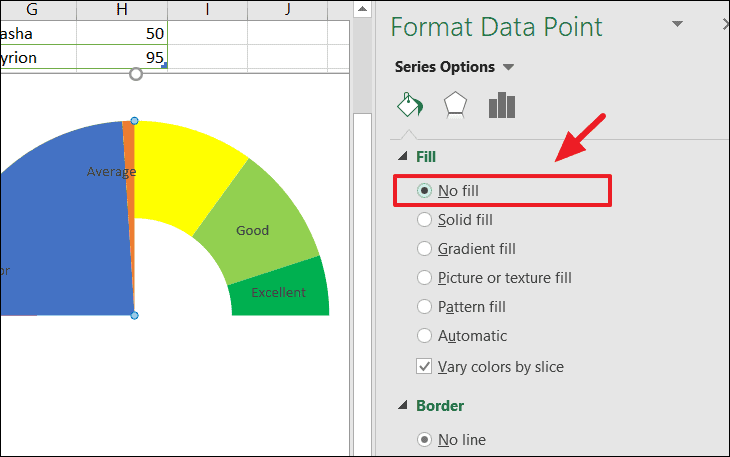
Step 13: Select the remaining thin slice (the pointer), and in the Format Data Point pane, choose a fill color for the needle, such as black or any color of your preference.
Your gauge chart now features a functional pointer, resembling a speedometer.

Understanding How the Gauge Chart Works
With the gauge chart complete, it's beneficial to see how it functions. The position of the needle is determined by the 'Pointer' value in your pointer data table.
Step 14: To dynamically display this value on your chart, you can add a text box that updates automatically. Go to the Insert tab and click on the Text Box icon within the Text group.

Draw the text box on your chart where you'd like the value to appear. Click inside the text box, then go to the formula bar, type =, and select the cell containing the 'Pointer' value (e.g., cell E3). Press Enter to link the text box to that cell. You can format the text box's font and size as desired.

Now, whenever you change the value in the 'Pointer' cell, the needle on the gauge chart and the linked text box will update automatically. This allows you to assess performance metrics or other data points easily.
Here's an example of the gauge chart in action with updated data:

You can also adjust the needle's thickness by modifying the 'Thickness' value in your pointer data table.
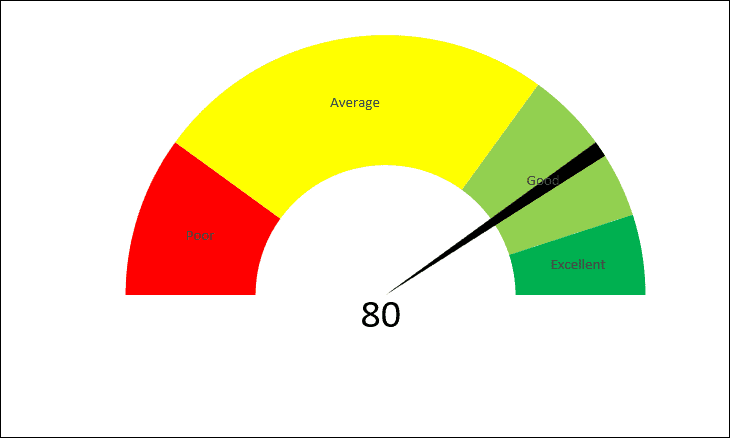
By following these steps, you've successfully created a dynamic gauge chart in Excel that can visually represent data against a defined performance scale.


